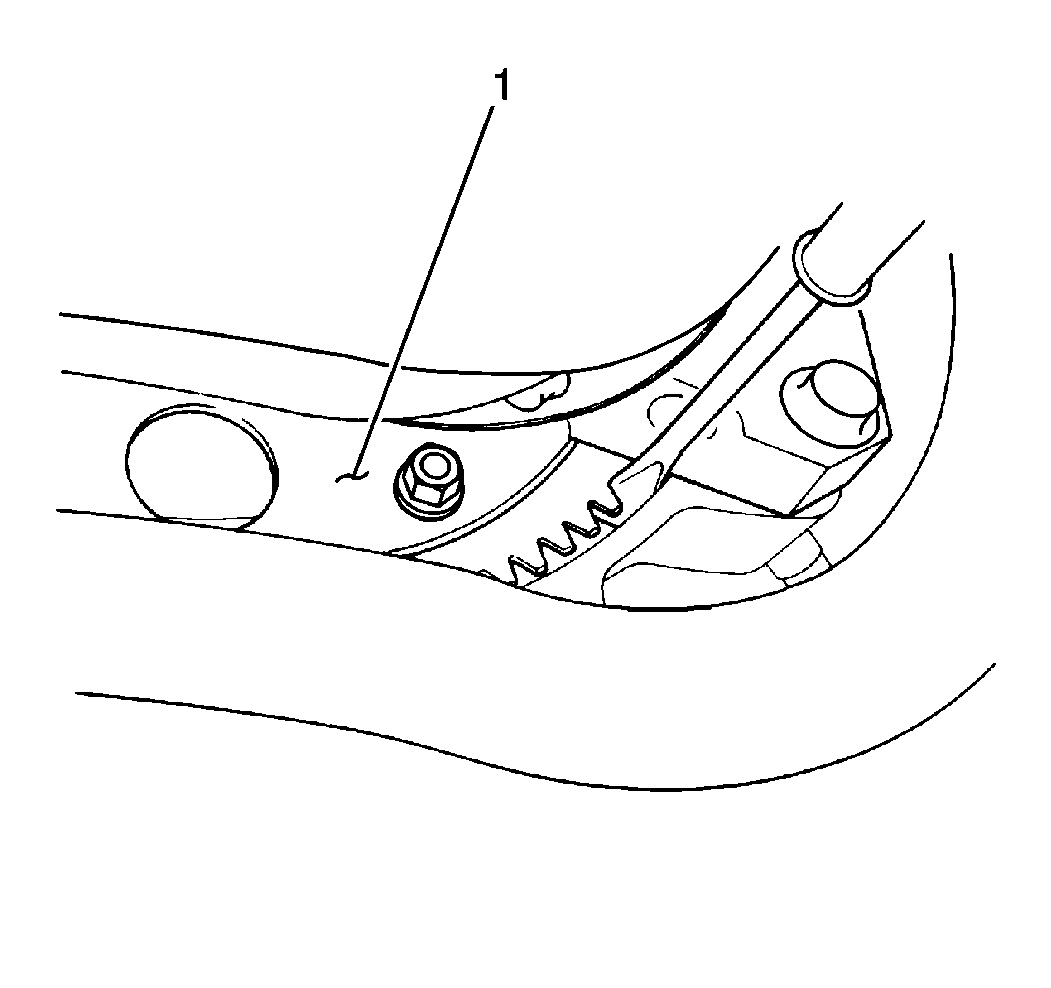Removal Procedure
- Disconnect the negative battery cable.
- Raise and support the vehicle. Refer to Lifting and Jacking the Vehicle in General Information.
- Remove the engine oil pan and the oil pump strainer. Refer to Oil Pan Replacement .
- Remove the timing belt. Refer to Timing Belt Replacement .
- Place a slotted screwdriver into a square hole (1) in the clutch housing (2) in order to lock the crankshaft on a vehicle equipped with a manual transaxle.
- Place a slotted screwdriver between the teeth of the flywheel (1) in order to lock the crankshaft on a vehicle equipped with an automatic transaxle.
- Remove the crankshaft timing gear bolt (1).
- Remove the crankshaft timing gear (2).
- Lower the vehicle.
- Remove seven oil pump mounting bolts and the oil pump (5) from the cylinder block that has a rubber seal.
- Remove the rotor plate pins from the oil pump (5).
Caution: Unless directed otherwise, the ignition and start switch must be in the OFF or LOCK position, and all electrical loads must be OFF before servicing any electrical component. Disconnect the negative battery cable to prevent an electrical spark should a tool or equipment come in contact with an exposed electrical terminal. Failure to follow these precautions may result in personal injury and/or damage to the vehicle or its components.




Installation Procedure
Tools Required
| • | J 34853 Crankshaft Oil Seal Guide |
| • | J 37747 Crankshaft Front Oil Seal Installer |
- Install the rotor plate pins into the oil pump body (5).
- Use a J 37747 in order to install the crankshaft oil seal into the oil pump body.
- Apply engine oil to a J 34853 .
- Fit the J 34853 to the crankshaft.
- Install the oil pump to the cylinder block.
- Remove the J 34853 .
- Apply Loctite® pipe sealant GM P/N 12346004 or the equivalent to the thread portion of the short oil pump mounting bolt (1) indicated.
- Install the oil pump mounting bolts (2) to the oil pump assembly.
- Install the rubber seal (2) between the oil pump (1) and the coolant pump (3).
- Use a sharp knife in order to cut off the edge of the oil pump gasket if the edge of the gasket bulges out.
- Install the crankshaft timing gear.
- Lock the crankshaft with a slotted screwdriver.
- Secure the timing assembly with a crankshaft timing gear bolt.
- Install the engine oil pan and the oil pump strainer. Refer to Oil Pan Replacement .
- Install the timing belt. Refer to Timing Belt Replacement .
- Lower the vehicle.
- Refill the engine oil to specifications. Refer to Approximate Fluid Capacities in Maintenance and Lubrication.
- Connect the negative battery cable.
- Run the engine in order to inspect the engine oil pressure. Refer to Oil Pressure Diagnosis and Testing .


Important: Ensure that the oil seal lip is not turned out during oil pump installation.
Use the J 34853 in order to install the oil seal over the crankshaft.

Notice: Use the correct fastener in the correct location. Replacement fasteners must be the correct part number for that application. Fasteners requiring replacement or fasteners requiring the use of thread locking compound or sealant are identified in the service procedure. Do not use paints, lubricants, or corrosion inhibitors on fasteners or fastener joint surfaces unless specified. These coatings affect fastener torque and joint clamping force and may damage the fastener. Use the correct tightening sequence and specifications when installing fasteners in order to avoid damage to parts and systems.
Tighten
Tighten the oil pump mounting bolts to 11 N·m (97 lb ft).


Verify that the edge is smooth and flush with the end faces of the pump case and the cylinder block.
Tighten
Tighten the crankshaft timing gear bolt to 130 N·m (96 lb ft).
